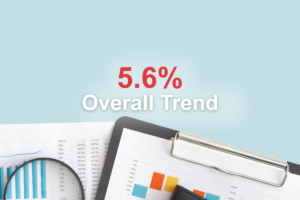Glucagon-like peptide 1 (GLP-1s) are a class of medications used to treat diabetes that can also lead to weight loss. Since 2021, GLP-1s have been in high demand, surpassing insulins as the top drug for spend in the antidiabetic class. They have become a notable driver of non-specialty and overall prescription drug trend. Products in this class of drugs include injectable semaglutide (Ozempic), oral semaglutide (Rybelsus), injectable dulaglutide (Trulicity), injectable terzepatide (Mounjaro) or injectable liraglutide (Victoza) for diabetes and injectable semaglutide (Wegovy) or injectable liraglutide (Saxenda) for weight loss. In the first part of 2023, National CooperativeRx groups are seeing on average an 8% month-over-month (PMPM) increase in spend for the antidiabetic GLP-1s and an 18% increase for the weight loss GLP-1s. Keep in mind, most groups do not cover weight loss, so those that do are seeing greater increases. If these rates continue, the costs for GLP-1s in 2023 will more than double what plans saw in 2022.
Factors Driving Demand for GLP-1s
Pharmaceutical Innovation
Advancements in drug formulations and research can affect demand for GLP-1s.
- The newest versions of GLP-1s have the benefit and appeal of being administered just once weekly compared to older versions that require daily administration.
- When used at the lower diabetes dosing, newer branded antidiabetic formulations may be less costly than the weight loss formulations.
- Older generic and inexpensive obesity products typically demonstrate weight loss of 5% to 10%. Whereas newer branded and more expensive anti-obesity products typically demonstrate weight loss of 10% to 15%. The newest formulation pending FDA approval may see up to 20% weight loss.
- Drug makers are exploring additional uses for these agents (fatty liver disease, coronary atherosclerosis, etc.)
- Additional products are expected to be approved as drug makers increase their development of these products. For example, Pfizer is reportedly working on an oral formulation that may rival the weight loss seen with current injectable options.
- GLP-1s are part of recent treatment guidelines by the American Diabetes Association as first-line therapy when there are high cardiovascular risk factors.
Demographics
- Only an estimated 1/3 of type 2 diabetics may be currently using GLP-1s, leaving plenty of room for growth. If all remaining type 2 diabetics were to utilize GLP-1s, plans could expect up to a 45% increase in their overall pharmacy benefit spend.
- About 40% of the population is obese, so there is significant potential for off-label use of the antidiabetic formulations for weight loss.¹ If just 50% of this population utilized GLP-1s for weight loss (off-label or otherwise), plans may expect more than a doubling of their overall pharmacy benefit spend.
Marketing
- Social media is actively promoting off-label use of antidiabetic formulations for weight loss.
- Pharma is positioning these products as maintenance drugs to be used long-term for chronic conditions (diabetes or obesity).
- Drug maker copay card programs mitigate financial barriers.
- Online clinics are popping up with telemedicine providers who are marketing weight loss services and assistance.
Prescribers
GLP-1s have received great acceptance and appeal amongst the prescriber community even though, as with any medications, there are risk-to-benefit considerations.
- Prescribers appear to be comfortable using diabetes products for off-label purposes such as weight loss but at the doses approved for the diabetes indication(s).
- There is a strong desire by healthcare professionals to prescribe medications for weight loss in response to the obesity epidemic, which is a major contributor to some of the leading causes of death in the U.S., including heart disease, stroke, diabetes, and some types of cancer.
- Prescribers find and take the path of least resistance. If weight loss medications are rejected at the point of sale, they will prescribe a diabetes medication. Therefore, the prescriber may avoid potential conflict with the patient and avoid the hassle of utilization management requirements by finding an alternative medication.
Plan Design
Generally, pharmacy benefit plans opt to restrict the use of weight loss formulations to certain populations or exclude them altogether while leaving access relatively unrestricted for diabetes formulations.
- Many plans have insufficient member cost shares to mitigate the influence of copay card incentives for GLP-1 products. With little to no out-of-pocket costs, financial deterrents may be mitigated and lead to higher utilization. In the case of GLP-1s, at the time of this publication release, copay card values may cover about 15% of the cost:
- Antidiabetic formulations
- $150 per month
- Consumers paying as little as $25 per month
- Weight loss formulations
- $225 per month with commercial insurance
- Consumers paying as little as $0 per month
- Antidiabetic formulations
- Lack of coverage and prior authorization for weight loss products appear to be creating demand for the diabetes formulations.
- PBM utilization management strategies may have shortcomings and leave plan sponsors paying for products they do not intend to. Recognizing loopholes is a must.
National CooperativeRx Recommendations
One of the value-added services National CooperativeRx provides to its members and partners is the monitoring of market dynamics and ongoing re-evaluation of clinical and plan design strategies. Historically, the coverage of weight loss medications with utilization management has been our recommendation. Due to evolving market dynamics, the historic recommendations have been revised.
RECOMMENDATIONS FOR PLAN SPONSORS TO CONSIDER INCLUDE:
- Re-examination of plan coverage and exclusions
- Work to develop your organization’s philosophy and clarify intent to develop a comprehensive strategy to improve health and mitigate costs.
- Re-evaluation of member cost shares
- Meet or exceed copay card values.
- Incentivize generic options/discourage brand options.
- Differential cost shares by drug class.
- Consider a utilization management strategy for GLP-1s
- Antidiabetic Formulations
- CVS/caremark’s featured strategy includes smart edits, step therapy, and prior authorization. It is no cost to implement, but it will not mitigate all off-label use. Preliminary results suggest this may decrease costs around 30%. Over time, this may diminish by more than half as prescribers become familiar with requirements and adapt to working the system.
- National CooperativeRx’s custom strategy is a buy-up program that requires a type 2 diabetes diagnosis for all antidiabetic formulations for GLP-1s. Therefore, it will mitigate more off-label use. Groups who have cross-referenced pharmacy and medical claims data are finding only about 50% of individuals have medical claim encounters for type 2 diabetes.
- Weight Loss Formulations
- If coverage is provided, consider prior authorization to ensure weight loss products are being used in accordance with current clinical guidelines.
- Antidiabetic Formulations
The National CooperativeRx team is readily available to analyze and discuss the best practices for each of our member groups. Please reach out to your strategic account executive if you are interested in reviewing your member groups’ plan design.
1. Centers for Disease Control and Prevention. (2022, May 17). Adult Obesity Facts. Centers for Disease Control and Prevention. https://www.cdc.gov/obesity/data/adult.html




